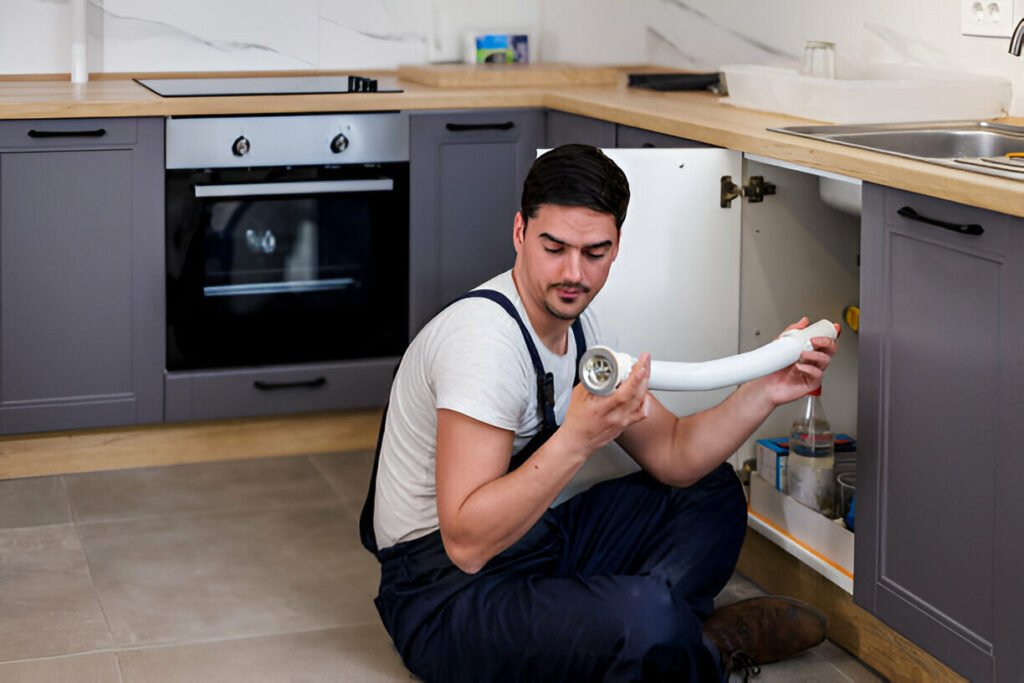A blocked kitchen drain can be a real headache, disrupting your daily routine and causing unpleasant odors. Luckily, unblocking a kitchen drain is often a task you can handle yourself with the right tools and knowledge. This comprehensive guide will help you understand the causes, methods, and prevention tips for dealing with a blocked kitchen drain.
Understanding the Problem
Common Causes of Kitchen Drain Blockages
Blocked kitchen drains are usually caused by:
- Food Particles: Small bits of food can accumulate over time, creating a blockage.
- Grease and Fat: When grease and fat are poured down the drain, they can solidify and cause blockages.
- Soap Scum: Soap residue can combine with grease and food particles, forming a solid blockage.
- Foreign Objects: Items like utensils, straws, and even jewelry can accidentally fall into the drain and cause a blockage.
Signs of a Blocked Kitchen Drain
Identifying the early signs of a blockage can help you address the issue before it becomes severe:
- Slow Draining Water: Water takes longer than usual to drain.
- Unpleasant Odors: Foul smells coming from the drain.
- Gurgling Sounds: Strange noises from the drain when water flows through it.
- Standing Water: Water pooling in the sink and not draining away.
Initial Steps to Take
Safety First
Before you start unblocking your kitchen drain, take some safety precautions:
- Wear Gloves: Protect your hands from dirty water and debris.
- Use Goggles: Prevent any splashes from getting into your eyes.
Assess the Blockage
Remove the sink strainer or stopper and look into the drain. Use a flashlight if necessary to see if the blockage is near the surface.
DIY Methods for Unblocking a Kitchen Drain
Boiling Water
One of the simplest methods to clear minor blockages is using boiling water.
- Boil Water: Boil a kettle or pot of water.
- Pour Slowly: Slowly pour the boiling water down the drain in stages.
- Repeat if Necessary: Repeat this process two to three times if the water doesn’t drain immediately.
Baking Soda and Vinegar
A natural and effective solution involves using baking soda and vinegar.
- Pour Baking Soda: Pour one cup of baking soda down the drain.
- Add Vinegar: Follow with one cup of vinegar. The mixture will fizz and bubble.
- Wait: Let it sit for 15-20 minutes.
- Flush with Hot Water: Flush the drain with boiling water to clear any remaining debris.
Plunger
A plunger can create suction to dislodge blockages.
- Create a Seal: Ensure there’s enough water in the sink to cover the plunger’s base. Place the plunger over the drain to create a seal.
- Plunge: Push down and pull up rapidly to create suction.
- Repeat: Repeat several times until the water starts to drain.
Plumbing Snake or Auger
For deeper blockages, a plumbing snake (or auger) is very effective.
- Insert the Snake: Feed the snake into the drain until you feel resistance.
- Twist and Push: Rotate the snake to break up the blockage and push it through the pipe.
- Remove the Snake: Carefully retract the snake, pulling out any debris.
Advanced Techniques
Using a Wet and Dry Vacuum
A wet and dry vacuum can suck out the blockage.
- Set Up the Vacuum: Set your vacuum to the wet setting and place the hose over the drain.
- Seal the Drain: Create a tight seal around the hose with a wet cloth.
- Suck Out the Blockage: Turn on the vacuum to suck out the blockage.
Chemical Drain Cleaners
Chemical drain cleaners should be used sparingly and as a last resort due to their harsh nature.
- Read Instructions: Follow the manufacturer’s instructions carefully.
- Pour the Cleaner: Pour the recommended amount into the drain.
- Wait and Flush: Wait for the specified time before flushing the drain with water.
When to Call a Professional
Persistent Blockages
If you’ve tried multiple methods and the blockage persists, it’s time to call a professional plumber. Persistent blockages may indicate a more severe issue that requires expert attention.
Multiple Blockages
If you experience blockages in multiple drains simultaneously, this could indicate a problem with your main sewer line, requiring professional intervention.
Sewage Backup
If you notice sewage backing up into your sink, contact a plumber immediately. This is a serious issue that needs urgent attention.
Preventive Measures
Regular Maintenance
Keep your kitchen drain clear with regular maintenance:
- Hot Water Flushes: Once a week, flush your drain with hot water to clear minor blockages and prevent build-up.
- Baking Soda and Vinegar: Monthly use of baking soda and vinegar can help maintain a clear drain.
Proper Disposal
Dispose of grease, fat, and food particles properly:
- Grease and Fat: Pour grease and fat into a container and dispose of it in the trash.
- Food Particles: Scrape food scraps into the trash or compost bin before washing dishes.
Drain Strainers
Use a drain strainer to catch food particles and debris:
- Install a Strainer: Place a strainer over your drain to catch debris.
- Clean Regularly: Empty the strainer regularly to prevent build-up.
Avoid Harsh Chemicals
Minimize the use of harsh chemical cleaners that can damage your pipes over time.
FAQs
How often should I clean my kitchen drain?
It’s recommended to clean your kitchen drain at least once a month using baking soda and vinegar or hot water flushes.
Can boiling water damage my pipes?
Boiling water is safe for most types of pipes, including metal and PVC, but avoid using it if you have older or brittle pipes.
What should I do if water is backing up into my sink?
If water is backing up, try using a plunger or plumbing snake first. If the problem persists, call a professional plumber.
Are chemical drain cleaners safe to use?
Chemical drain cleaners can be effective but should be used sparingly as they can damage pipes and are harmful to the environment.
How can I prevent future blockages?
Prevent future blockages by avoiding pouring grease down the drain, using a drain strainer, and regularly maintaining your drain with hot water flushes or natural cleaners.
Conclusion!!
A blocked kitchen drain can be a frustrating problem, but with the right approach, it’s often something you can fix yourself. By understanding the common causes, using effective DIY methods, and taking preventive measures, you can keep your kitchen drain clear and functional. Regular maintenance and proper disposal of kitchen waste are key to preventing future blockages.







